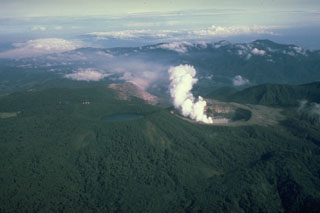Report on Poas (Costa Rica) — 5 March-11 March 2025
Smithsonian Institution / US Geological Survey
Weekly Volcanic Activity Report, 5 March-11 March 2025
Managing Editor: Sally Sennert.
Please cite this report as:
Global Volcanism Program, 2025. Report on Poas (Costa Rica) (Sennert, S, ed.). Weekly Volcanic Activity Report, 5 March-11 March 2025. Smithsonian Institution and US Geological Survey.
Poas
Costa Rica
10.2°N, 84.233°W; summit elev. 2697 m
All times are local (unless otherwise noted)
The Observatorio Vulcanológico y Sismológico de Costa Rica-Universidad Nacional (OVSICORI-UNA) reported that eruptive activity at Poás intensified during 1-2 March and continued at a high level through 11 March. Frequent phreatic eruptions during 4-7 March ejected material as high as 50 m above the crater floor. The phreatic eruptions were almost continuous at Boca C and sporadic and Boca A. Radial deformation and inflation was detected in and around the crater, and the rate of deformation was increasing. The lake level had dropped, and the water was separated into two small ponds. An analysis of monitoring data suggested that there were disturbances of the magmatic system at depth which increased the probability of dangerous eruptions within the Parque Nacional Volcán Poás within the next few days or weeks. At 1330 on 7 March the Alert Level was raised to 3 (the second highest level on a four-level scale) and the Aviation Color Code was raised to Orange (the second highest color on a four-color scale).
Small frequent phreatic eruptions, mostly at Boca C, continued during 8-9 March. In a special report issued at 1000 on 9 March OVSICORI-UNA reported that two shock waves identified in infrasound data signified an eruptive event. Steam plumes rose several hundred meters and material was likely ejected as high as 200 m above the vent, though visual confirmation was obscured by the plumes. Phreatic eruptions at 1053, 1236, and 1821 on 9 March generated gas-and-steam plumes that rose as high as 1 km; the plumes obscured views of the crater. Sulfur dioxide emissions detected in satellite data averaged 538 tons per day. Notably, during the evening, eight volcano-tectonic events associated with rock fracturing were recorded in both seismic and infrasound data. Activity continued during 9-10 March mainly from Boca C and some from Boca A. The phreatic eruptions ejected material 200-400 m above the crater floor and generated steam-and-gas plumes that rose as high as 1 km. The ponds continued to shrink and the water had a high sediment content. Blocks up to 1 m in diameter were ejected from the vents onto the crater floor and sediments rich in native sulfur were deposited around the edges of the small ponds. Eruptive activity continued on 11 March at similar levels, moderate- to high-level tremor was recorded, and inflation continued.
Geological Summary. The broad vegetated edifice of Poás, one of the most active volcanoes of Costa Rica, contains three craters along a N-S line. The frequently visited multi-hued summit crater lakes of the basaltic-to-dacitic volcano are easily accessible by vehicle from the nearby capital city of San José. A N-S-trending fissure cutting the complex stratovolcano extends to the lower N flank, where it has produced the Congo stratovolcano and several lake-filled maars. The southernmost of the two summit crater lakes, Botos, last erupted about 7,500 years ago. The more prominent geothermally heated northern lake, Laguna Caliente, is one of the world's most acidic natural lakes, with a pH of near zero. It has been the site of frequent phreatic and phreatomagmatic eruptions since an eruption was reported in 1828. Eruptions often include geyser-like ejections of crater-lake water.
Source: Observatorio Vulcanologico y Sismologico de Costa Rica-Universidad Nacional (OVSICORI-UNA)

